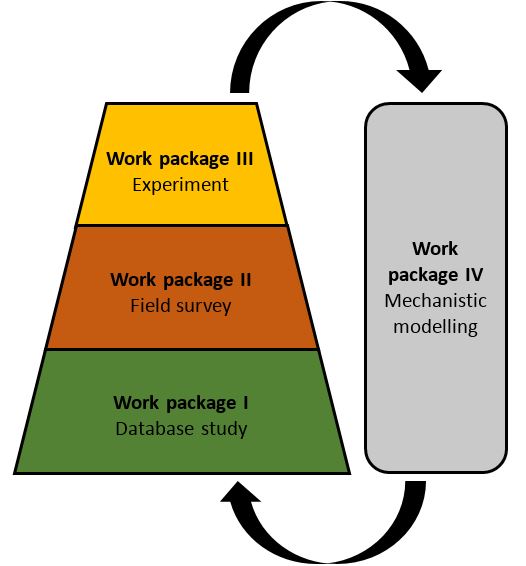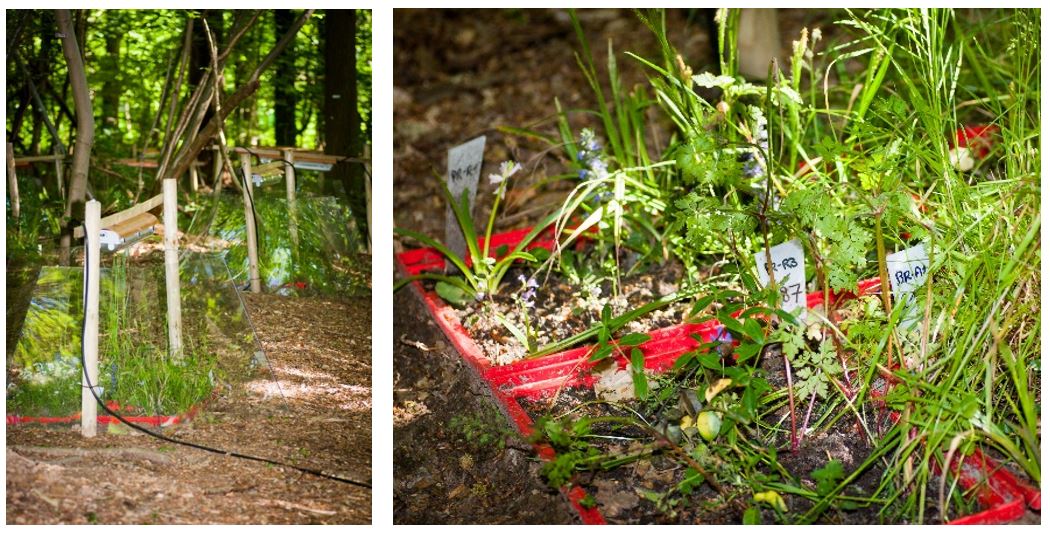Project summary
Contact: Kris Verheyen
The last decades are characterized by an upsurge of research on the impacts of global environmental changes on forests. Climate warming, polluting atmospheric deposition and land-use change are three of the most important threats to biodiversity in temperate forests. Our ability to predict the combined effects of these global change drivers over longer time periods remains rudimentary. The lack of knowledge on effects of global change drivers on forest herb layer communities is particularly striking, since the herb layer contains the largest part of vascular plant diversity in temperate forests and provides key ecosystem services. To further our understanding, Kris Verheyen, professor of forest ecology at Ghent University, initiated the PASTFORWARD research project, funded by an ERC consolidator grant in 2014.
The project investigates how herb layer communities in temperate forests have changed over time and how they will change in the near future. More specifically, the projects aims at understanding the interactive effects of land-use change, atmospheric deposition and climate warming on these herb layer changes. The central idea behind the project is that changes in herb layer communities are driven primarily by past land use, but can be modulated by atmospheric deposition, climate warming and forest management, and that sensible predictions of herb layer development trajectories under global change can only be made by taking the forest’s land-use history into account. The project’s findings will help forest managers and policy makers in taking informed decisions on how to combine forestry with biodiversity conservation.
 The combined effects of land use legacies and global change on forest herb layer communities will be studied in four tightly linked work packages, including a database study (work package I), a pan-European field survey (work package II), a controlled experiment (work package III) and mechanistic modelling (work package IV). Going from work package I to work package III, changes in herb layer community composition are studied with an increasing level of detail. While findings from the first work package will provide general insights on responses of understorey communities to past land use and global change, findings from work package II and III will provide more insights on the mechanisms behind these responses. Work package IV will combine the data and outcomes of the other work packages to calibrate and validate a mechanistic model that allows predicting trajectories of forest herb community development under different scenarios of global change.
The combined effects of land use legacies and global change on forest herb layer communities will be studied in four tightly linked work packages, including a database study (work package I), a pan-European field survey (work package II), a controlled experiment (work package III) and mechanistic modelling (work package IV). Going from work package I to work package III, changes in herb layer community composition are studied with an increasing level of detail. While findings from the first work package will provide general insights on responses of understorey communities to past land use and global change, findings from work package II and III will provide more insights on the mechanisms behind these responses. Work package IV will combine the data and outcomes of the other work packages to calibrate and validate a mechanistic model that allows predicting trajectories of forest herb community development under different scenarios of global change.
Scientific work within the project is carried out by a group of researchers, affiliated to the Forest & Nature Lab at Ghent University, including Kris Verheyen (principal investigator), Haben Blondeel, Emiel De Lombaerde, Leen Depauw, Dries Landuyt, Sybryn Maes, Mike Perring and Elyn Remy. Technical support is provided by Kris Ceunen.
Work package I - Database study
Contact: Mike Perring
This work package aims at finding general trends concerning the effect of past land use on past changes in herb layer communities in temperate forests. This study is predominantly based on data extracted from the forestREplot database. The forestREplot database is a unique database of forest herb-layer resurvey plots, currently spread across the temperate zones of Europe and North America. To determine the impact of past land use and how it interacts with the above-mentioned global change drivers, the database will be supplemented with detailed information on land management history. Through statistical modelling, main and interactive effects of past land use, on the one hand, and global change drivers, on the other hand, are being identified.
Work package II - Observational study
Contact: Leen Depauw, Sybryn Maes
.jpg)
To complement work package I, additional, more detailed field measurements are carried out in a smaller number of resurvey plots, spread over 19 European study sites. The different sites cover a gradient in climate conditions and atmospheric deposition rates, while the plots within each study site cover similar site characteristics, but distinct classes of past land use (e.g. ancient vs. recent forest plots). The measurements aim at obtaining more detailed, plot-specific info, focusing on the present and past biotic and abiotic conditions. This spatio-temporal design will allow to disentangle the effects of the three drivers of change on understorey communities with a more process-based understanding.
Work package III - Experiment
Contact: Haben Blondeel, Emiel De Lombaerde

By experimentally applying global change treatments to herb layer communities, this work package seeks to disentangle effects of increased temperature, atmospheric deposition and light availability on herb layer trajectories across a distinct land-use gradient. Starting from initially similar communities in a controlled environment grown on soil from different regions across Europe, we will test whether different trajectories develop depending on their position on the land-use gradient and how these trajectories are modulated under the treatments of global change.
Work package IV - Mechanistic modelling
Contact: Dries Landuyt
Gained process understanding within the project will be integrated in a mechanistic model that enables predicting changes in understorey communities for given global change projections. As no truly mechanistic models for modelling understorey community dynamics exist, a new model, that combines concepts from grassland models and forest gap models, is being developed. The main aim of this work package is to evaluate how current management decisions might impact future herb layer community changes, in terms of biodiversity and functional composition.